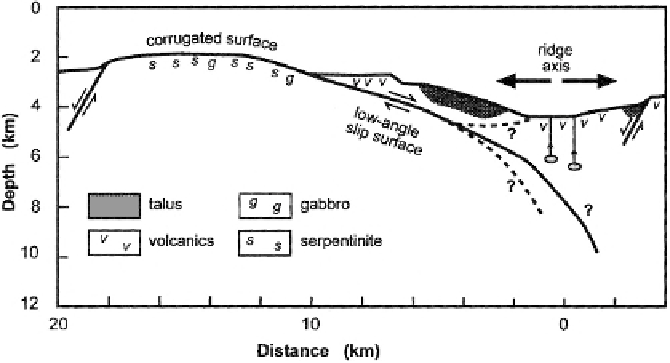Geoscience Reference
In-Depth Information
(c)
Figure 9.19.
(
cont.
) (c) A cartoon cross section of an active inside corner close to a
transform fault on a slow-spreading ridge. Compare this with (a) and (b). The
geometry of the detachment surface at depth is unknown. Three possible subsurface
positions for the active fault are indicated by '?': (1) it could steepen towards the
median valley, effectively detaching much of the lower crust and upper mantle from
the upper basaltic crust; (2) it could have a more or less constant low-angle dip
(although this would mean that it crossed the ridge axis); and (3) it could be a major
failure surface outcropping at the seabed on the median valley floor at the foot of a
slipped upper-crustal block. (Reprinted with permission from
Nature
(Cann
et al
.
Nature
, 385, 329-32). Copyright 1997 Macmillan Magazines Ltd.).
the actual extrusion zone of lavas onto the sea floor is probably only a few hundred
metres wide.
The comparison of ophiolites with the oceanic crust initially resulted in a
number of models (of varying degrees of complexity) of magma chambers in
the crust at shallow depth beneath the ridge axis. These models were nicknamed
'infinite onions', infinite because of their continuity in time and along the axis
of the mid-ocean-ridge system, terminated only by transform faults, and onion
because of their shape and because they peel off layers of oceanic crust at their
sides. These magma chambers were thought to produce the basaltic lavas which
are erupted onto the seafloor, as well as the underlying dykes and cumulate layers
which are present in ophiolites and are thought to make up much of seismic
layers 2 and 3. Several thermal models of crustal magma chambers have been
made in order to determine limits on their size and dependence on spreading
rate, crystal settling and thermal parameters. Clearly, an infinite-onion magma
chamber, extending through much of the crust and being several kilometres in
width, should be easily detectable seismically. Many detailed seismic-reflection,
seismic-refraction, gravity and deep-tow surveys have been carried out in order
to delineate magma chambers on the Mid-Atlantic Ridge, Reykjanes Ridge, East



